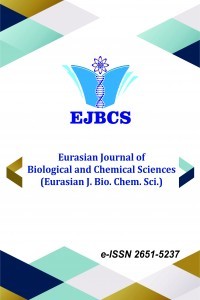Drosophila melanogaster’in somatik hücrelerinde kobalt nanopartiküllerinin indüklediği genotoksisiteye karşı resveratrol’ün antigenotoksik etkisi
Son yıllarda gelişen teknoloji ile birlikte yeni teknolojik ürün olarak nanopartikül (NP,
Anahtar Kelimeler:
Drosophila melanogaster, Kobalt nanopartikül, Resveratrol, Antigenotoksisite, SMART, COMET
Antigenotoxic effect of resveratrol against genotoxicity induced by cobalt nanoparticles in somatic cells of Drosophila melanogaster
With the developing technology in recent years, the production of nanoparticles (NP,
Keywords:
Drosophila melanogaster, Cobalt nanoparticle, Resveratrol, Antigenotoxicity, SMART, COMET,
___
- Barker PE, Butler T, Dawley JM, Herran, P, King B, Nathanson KL, Patel K, Wedeking J, Weiss H, Wubinger J, Ziesmann S. 2006.Nanotechnology Briefing Paper: Clean Water Act, in Section of Environment, Energy, and Resources. American Bar Association. Chicago, IL.
- Bernhardt ES, Colman BP, Hochella MF, Cardinale BJ, Nisbet RM, Richardson CJ, Yin Liyan 2010. An Ecological Perspective on Nanomaterial Impacts in the Environment. Journal of Environmental Quality. 39:1-12.
- Carmona ER, Inostroza-Blancheteau C, Obando V, Rubio L, Marcos R. 2015a. Genotoxicity of copper oxide nanoparticles in Drosophila melanogaster. Mutation Research. 791:1-11.
- Carmona ER, Inostroza-Blancheteau Rubio, L, Marcos R. 2015b. Genotoxic and oxidative stres potential of nanosized and bulk zinc oxide particles in Drosophila melanogaster. Toxicology and Industrial Health. 32:1987-2001.
- Colvin V. 2003.The potential environmental impacts of engineered nanomaterials. Nature Biotechnology, 21, 1166-70.
- Das DK, Maulik N. 2006. Resveratrol in cardioprotection: a therapeutic promise of alternative Medicine. Molecular Interventions. 6:36-47.
- Demir, E, Kocaoğlu S, Kaya B. 2008a. Protective Effects of Chlorophyll Against the Genotoxicity of UVB in Drosophila SMART Assay. Fresenius Environmental Bulletin. 17:2180-6.
- Demir E, Kaya B, Kocaoglu S. 2013a. Antigenotoxic Activities of Ascorbic acid, Chlorophyll a and Chlorophyll b in Acrolein and Malondialdehyde-Induced Genotoxicity in Drosophila melanogaster. Ekoloji. 22:36-42.
- Demir E, Kaya B, Marcos R, Kocaoğlu S, Çetin H. 2013b. Investigation of the genotoxic and antigenotoxic properties of essential oils obtained from two Origanum species by Drosophila wing SMART assay. Turkish Journal of Biology. 37:129-38.
- Demir E, Kocaoğlu S, Cetin H, Kaya B. 2009. Antigenotoxic Effects of Citrus aurentium L. Fruit Peel Oil on Mutagenicity of Two Alkylating Agents and Two Metals in the Drosophila Wing Spot Test. Environmental and Molecular Mutagenesis. 50:483-8.
- Demir E, Kocaoğlu S, Kaya B. 2008b. Protection Against Ultraviolet B-Induced Genotoxicity by the Chlorophyllin in Drosophila melanogaster. Fresenius Environmental Bulletin. 17:2187-92.
- Demir E, Kocaoğlu S, Kaya B. 2010. Antigenotoxic properties of chlorophyllin and chlorophylls in the Drosophila wing spot test. Fresen. Environ. Bull. 19:3131-38.
- Feynman RP 1960. There’s Plenty of Room at the Bottom. Engineering and Science magazine. 23:no.5.
- Frei H, Wurgler FE. 1988. Statistical methods to decide whether mutagenic test data from Drosophila assays indicate a positive, negative or inconclusive results. Mutation Research. 203:297-308.
- Gogotsi Y. 2003. How safe are nanotubes and other nanofilaments. Materials Research Innovations. 7:192-4.
- Gokpinar S, Koray T, Akçiçek E, Göksan T, Durmaz Y. 2006. Algal Antioksidanlar. E.U. Su Ürünleri Dergisi. 23: 85-9.
- Graf U, Wurgler FE, Katz AJ, Frei H, Juan H, Hall CB, Kal, PG. 1984. Somatic Mutation and Recombination Test in Drosophila melanogaster. Environmental and Molecular Mutagenesis. 6:153-188.
- Irving P, Ubeda JM, Doucet D, Troxler L, Lagueux M, Zachary D, Hoffmann JA, Hetru C, Meister M. 2005. New insights into Drosophila larval haemocyte functions through genome-wide analysis. Cell Microbiolgy. 7:335-350.
- Kaya B, Yanikoğlu A, Creus A, Marcos R. 2000. Genotoxicity testing of five herbicides in the Drosophila wing spot test. Mutation Research. 465:77-84.
- Khan I, Saeed K, Khan I. 2019. Nanoparticles: Properties, applications and toxicities. Arabian Journal of Chemistry. 12:908-931.
- Krishn, RN, Gayathri R, Priya VD. 2017. Nanoparticles and Their Applications - A Review. Journal of Pharmaceutical Sciences and Research. 9:24-27.
- Lappas CM. 2015. The immunomodulatory effects of titanium dioxide and silver nanoparticles. Food and Chemical Toxicology, 85:78-83.
- Laurent S, Forge D, Port M, Roch A, Robi, C, Vander Elst L, Muller RN. 2008. Magnetic Iron Oxide Nanoparticles: Synthesis, Stabilization, Vectorization, Physicochemical Characterizations, and Biological Applications. Chemical Reviews. 108:2064-2110.
- Lee JG, Yon JM, Lim C, Jung AY, Jun, KY, Nam SY. 2012. Combined treatment with capsaicin and resveratrol anhances neuroprotection against glutamate-induced toxicity in Mouse cerebral cortical neurons. Food and Chemical Toxicology. 50:3877-85.
- Lux Report 2008. Nanomaterials state of the market: stealth success, broad impact. Avaible at: http://portal.luxresearchinc.com/research/document/3735 [16.11.21]
- Mahmoud A, Öztaş E, Arici M, Özhan G. 2016. In Vitro Toxicological Assessment of Magnesium Oxide Nanoparticle Exposure in Several Mammalian Cell Types. International Journal of Toxicology. 35:1-9.
- Mallebrera B, Brandolini V, Font G, Ruiz MJ. 2015. Cytoprotective effect of resveratrol diastereomers in CHO-K1 cells exposed to beauvericin. Food and Chemical Toxicology. 80:319-327.
- Nel A, Xia T, Mädler L, Li N. 2006. Toxic potential of materials at the nanolevel. Science. 311:622-7.
- Sayın O, Arslan N, Guner G. 2008. Resveratrol ve kardiyovasküler sistem. Turkish Journal of Biochemistry. 33:117-121.
- Strambeanu N, Demetrovici L, Dragos D, Lungu M. 2015. In: Lung M(ed) Nanoparticles’ Promises and Risks. Chapter 1: Nanoparticles: Definition, Classification and General Physical Properties. Springer International Publisihing, Switzerland.
- Theodore L, Kunz RG. 2005. Nanotechnology: Turning Basic Science into Reality. John Wiley & Sons, Inc.
- Zhang W, Xue J, Ge M, Yu M, Liu L, Zhang Z. 2013. Resveratrol attenuates hepatotoxicity of rats exposed to arsenic trioxide. Food and Chemical Toxicology. 51:87-92.
- Yayın Aralığı: Yılda 2 Sayı
- Başlangıç: 2018
- Yayıncı: Muhammet DOĞAN
Sayıdaki Diğer Makaleler
Kübra DANIŞ, Buse Nur BİNGÖL, Gökhan KARS
Thymoquinone Prevents Valproic Acid-Induced Nephrotoxicity in Rat Kidney
Sebile AZİRAK, Deniz TAŞTEMİR KORKMAZ, Sedat BİLGİÇ, Meltem ÖZGÖÇMEN, Mehmet Kaya ÖZER
Ayşen Yağmur KURŞUN, Burcin YALCİN, Merve GÜNEŞ, Ghada TAGORTİ, Bülent KAYA
SARS-COV-2 enfeksiyonu olan hastalarda laboratuvar parametrelerin prognoz değeri
Effects of different nitrogen sources on invertase production by Aspergillus niger
Özden CANLI TAŞAR, Gani Erhan TAŞAR
Omar Mahmood MOHAMMED, Haci Ahmet DEVECİ, Gökhan NUR
Biochemical Laboratory Findings on COVID-19 Patients: Pathogen-Disease Relationship
Aysel GÜVEN, Ertugrul ALLAHVERDİ, Tülay ALLAHVERDİ, Meriç ÇOLAK
